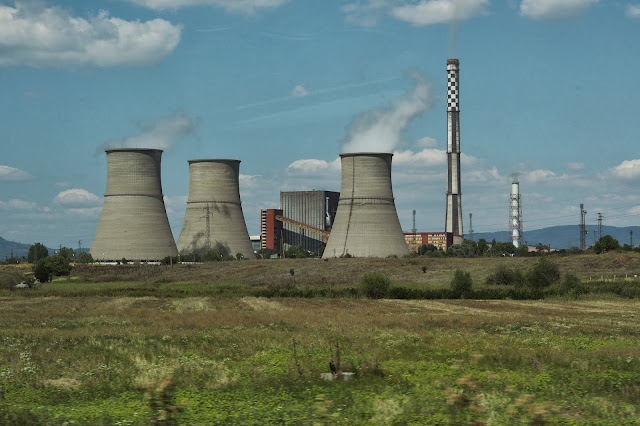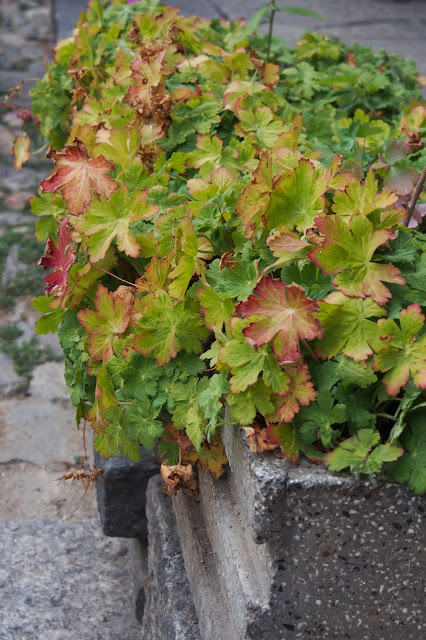We passed through field after fields of typical Adriatic crops: maize, canolas, olives etc
There were also mesa like hills
and from time to time woods
This one looks as if it's going to be a building site. Or is it going to be another rest stop?
And the occasional hut
Sometimes the land is heavily overgrown
Other fields look much drier
Apparently, people still use log fires in this part of the country
A whole pile of chopped logs besides our rest stop
Roadside flowers on our rest stop
Not only in yellow, but white too
and some lovely blue flowers
Roadside leaves
Sunlight and shadows
More sunlight and shadows
Beautiful blue daisy
Tiny button like yellow flowers
Splendours in blue
Is this a bird's feather or that of the grass?
A tiny white spider
Roadside leaves
Sunlight and shadows
More sunlight and shadows
Beautiful blue daisy
Tiny button like yellow flowers
Splendours in blue
Is this a bird's feather or that of the grass?
A tiny white spider
Men chatting
Lady Gaga in Bulgaria
We've crossed the border: the houses here got pop art murals upon them
The road we still got to cover
A power plant
Who is he? Jesus? What's he doing there in the middle of nowhere?
This is why we had to endure the 4 hour journey: the Rila Monastery or The Monastery of Saint Ivan of Rila 876 - 946 AD (Bulgarian: Рилски манастир, Rilski manastir), whose image appear on the reverse side of the 1 lev Bulgarian banknote issued in 1999. It's the largest and most famous Eastern Orthodox monastery in Bulgaria, right in the middle of southwestern Rila Mountains almost 3800 feet above sea level and some 73 miles south of Sofia, the Bulgarian capital, in the deep valley of the Rilska River. It was first built in the 10th century during the reign of Tsar Peter I (927-968). St. Ivan was a hermit living the life of an ascetic in a cave not far from the monastery built by students who came to listen to his talks. The monastery was supported by almost all of tsars of the the Second Bulgarian Empire up until the Ottoman Conquest in the 15th century, making the monastery a cultural and spiritual centre of Bulgarian national consciousness that reached its apogee from the 12th to the 14th century. The monastery was completely rebuilt by Hrelyu, a feudal lord under Serbian suzerainty, during the first half of the 14th century. However, the arrival of the Ottomans in the end of the 14th century was followed by numerous raids and a destruction of the monastery in the middle of the 15th century. But from donations by the Sultana Mara Branković, the Russian Orthodox Church and the Rossikon monastery of Mount Athos, the Rila Monastery was rebuilt in the end of the 15th century by three brothers from the region of Kyustendil. With Sultana Mara Branković's influence Ivan of Rila's relics were moved from Trnovo into the new complex in 1469. The monastery is very important in Bulgarian history because it stayed staunchly Bulgarian despite 4 centuries of Turkish rule and did its best to preserve the Bulgarian language and its culture. During the Bulgarian National Revival (18th-19th century), it was destroyed by fire in 1833 and then again rebuilt by the famous architect Alex Rilets between 1834 and 1862 with the help of wealthy Bulgarian. The erection of the residential buildings began in 1816, while a Neofit Rilski founded a school in the monastery during the period. The whole complex occupies an area of 8,800 m². It's built like a rectangular fort, centred around the inner yard (3,200 m²), where the tower and the main church are situated.
The main church of the monastery was erected in the middle of the 19th century. Its architect is Pavel Ioanov, who worked on it from 1834 to 1837. The church has five domes, three altars and two side chapels, while one of the most precious items inside is the gold-plated iconostasis, famous for its wood-carving, the creation of which took five years to four handicraftsmen. The frescoes, finished in 1846, are the work of many masters from Bansko, Samokov and Razlog, including the famous brothers Zahari Zograf and Dimitar Zograf. The church is also home to many valuable icons, dating from the 14th to the 19th century. Porticos in the courtyard have Mamluk influence with the striped painting and the domes, which became more popular in the Ottoman Empire after the conquest of Egypt. The four-storey (not counting the basement) residential part of the complex consists of 300 chambers, four chapels, an abbot's room, a kitchen (noted for its uncommonly large vessels), a library housing 250 manuscripts and 9,000 old printed matters, and a donor's room. There's a museum there, particularly famous for housing Rafail's Cross, a wooden cross made from a whole piece of wood (81×43 cm). It was whittled down by a monk named Rafail using fine burins and magnifying lenses to recreate 104 religious scenes and 650 miniature figures. Work on this piece of art lasted not less than 12 years before it was completed in 1802, when the monk lost his sight.
The main church of the monastery was erected in the middle of the 19th century. Its architect is Pavel Ioanov, who worked on it from 1834 to 1837. The church has five domes, three altars and two side chapels, while one of the most precious items inside is the gold-plated iconostasis, famous for its wood-carving, the creation of which took five years to four handicraftsmen. The frescoes, finished in 1846, are the work of many masters from Bansko, Samokov and Razlog, including the famous brothers Zahari Zograf and Dimitar Zograf. The church is also home to many valuable icons, dating from the 14th to the 19th century. Porticos in the courtyard have Mamluk influence with the striped painting and the domes, which became more popular in the Ottoman Empire after the conquest of Egypt. The four-storey (not counting the basement) residential part of the complex consists of 300 chambers, four chapels, an abbot's room, a kitchen (noted for its uncommonly large vessels), a library housing 250 manuscripts and 9,000 old printed matters, and a donor's room. There's a museum there, particularly famous for housing Rafail's Cross, a wooden cross made from a whole piece of wood (81×43 cm). It was whittled down by a monk named Rafail using fine burins and magnifying lenses to recreate 104 religious scenes and 650 miniature figures. Work on this piece of art lasted not less than 12 years before it was completed in 1802, when the monk lost his sight.
The entrance to the monastery. One can see how deep it is.
This church was also built during the 14th century. The monastery complex is regarded as one of the foremost masterpieces of
Bulgarian National Revival architecture and was declared a national
historical monument in 1976 and a UNESCO World Heritage Site in
1983. Since 1991 it has been entirely subordinate to the Holy Synod of
the Bulgarian Orthodox Church.
The exterior of the church is all covered by murals
Murals on the exterior of the church: Christ above with angels leading the faithfuls to celebrate the birth of Jesus
Angels aided by the saints on the left guided by the Holy Spirit with the Bible helping the children against the devils on the right
Another mural: the Holy Mother surrounded by angels
People led by devils and going to the witches
The devil stopping a girl from going to the priest
an angel doing the opposite
A passage from the Holy Bible
Our local guide
The entrance to the church: no photography inside it is allowed
A photographic peep of its interior from the exterior
Beautiful floral decoration above the arched door
The black and white bands is typical of Turkish-Egyptian architecture
One can see the same pattern on all the arches and columns
Behind the belfry is the Tower of Hrelyu.
How like the watch tower of a fortress?
This is the belfry, added in 1444 to the tower. To its left, we were told that it's the king's throne!
A throne? I wonder. Looks more like the mechanism for the clock to me!
A close up on the clock. The upper part of the arches are all decorated
Behind the monastery, one can see the surrounding hills
The courtyard is really huge
There are flowers outside the balustrades of the wooden railings on the corridor
full of flowers
A detail on the roof to one of the balconies built with wood
Beautiful grilles on the church window
iIliterate people listening to those who could read from the bible
An elaborate fountain of holy water outside the church
The same from a different angle
A girl wanting her picture taken before her beauty fades
I did. Why not?
The courtyard is lined with flower beds everywhere
leaves changing color in autumn
Trees lined the stone walls
The terrace of our restaurant
Our dining room
The windows are small and high up but the building is designed for draughts to run through from one part of the building to another for better circulation of air
The decoration on the wall: one can see the monastery is guided by soldiers of Christ: the religious on the left and the military on the right
A painting of how the monastery looked like before it was rebuilt?
We had our meals at the monastery. Our bread. Quite simple.
Our soup
Our meat. We were told that the normal monastery diet is vegetarian.
Our dessert
Beside the canteen restaurant is a small running stream
There's a narrow staircase leading up to the exit to the terrace on the first floor
The exit to the restaurant terrace
The lady who served us
Drinks for guests
Some people were dining on the terrace
More diners

Going back where we came from
Flowers on the way down
Raising its head so proudly in the sun
Beautiful tricolor pig's ears
In yellow, orange, white and purple
Another tricolor with quite complex color patterns
Beautiful begonia
What's on the mind of this girl in the bloom of her life?
The fountain of life: I am the water of life: those who drink through me shall have eternal life! With a brass ladle!
Play on light upon the corridors and stair landings
One of the corridors: the straight and narrow path
The end of the corridor: end of life?
The dome with crosses above pointing to heaven
We're on our way again
A railway bridge or a Roman aqueduct?
More rolling hills
The sun was low
The last rays
We passed by some dilapidated houses: we knew we were close to town
After another 3 hours journey, we arrived at our restaurant at Sofia of Bulgaria
it's decorated with all kinds of artifacts
model carts, jugs, bowls, baskets, ropes, vases, flowers
And even the head of an oriental looking doll!
Another cart and pot
What on earth is that wheel contraption on top? A device for launching an arrow?
and wine with grapes
All kind of dolls.
Shelf after shelves of tiny decorative items
and toy dresses: a literal toy shop!
and mats dishes and dresses. I'm sure its designer must be a woman
It seems she can never have enough of dresses!
And vases and flowers
chicken and wolf
An oven
an fireplace and watermill!
A Bulgarian horse shoe!
And flowers everywhere
On top of every pillar
Our soup and bread
Our stuffed pancake pie
Our dessert
It was quite dark when we left our restaurant
The tram of Sofia
Our hotel parking lot
And the hotel bar. But I was too tired for anything but a bath and bed.
































































































































沒有留言:
張貼留言